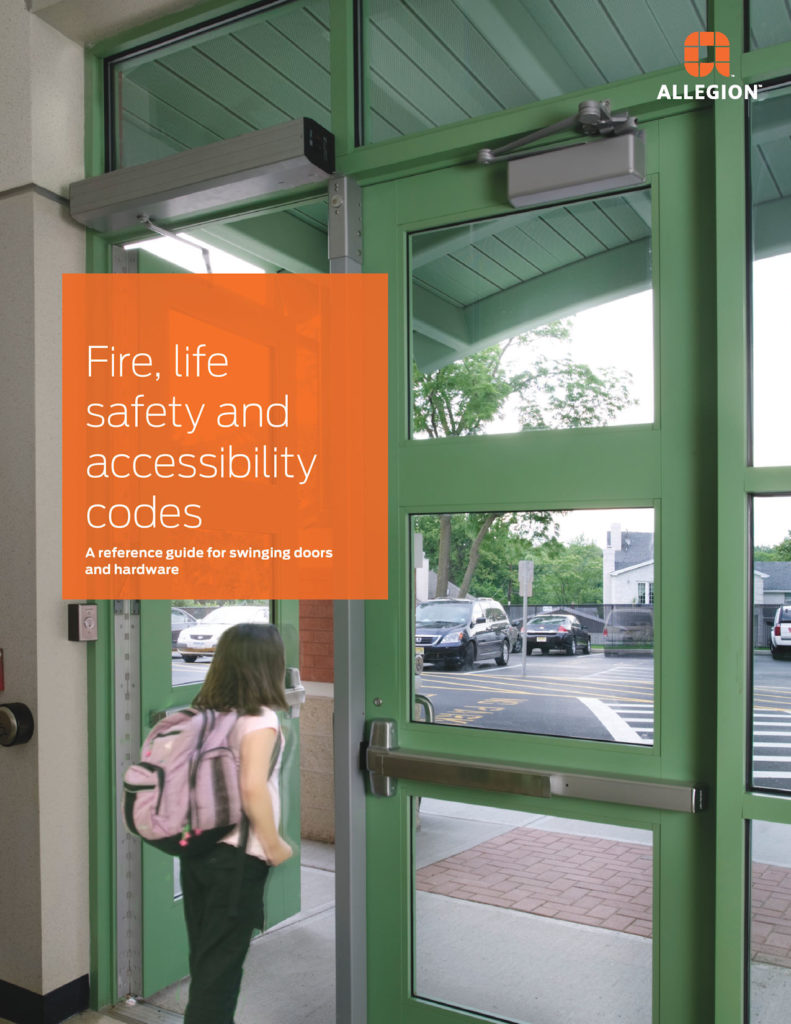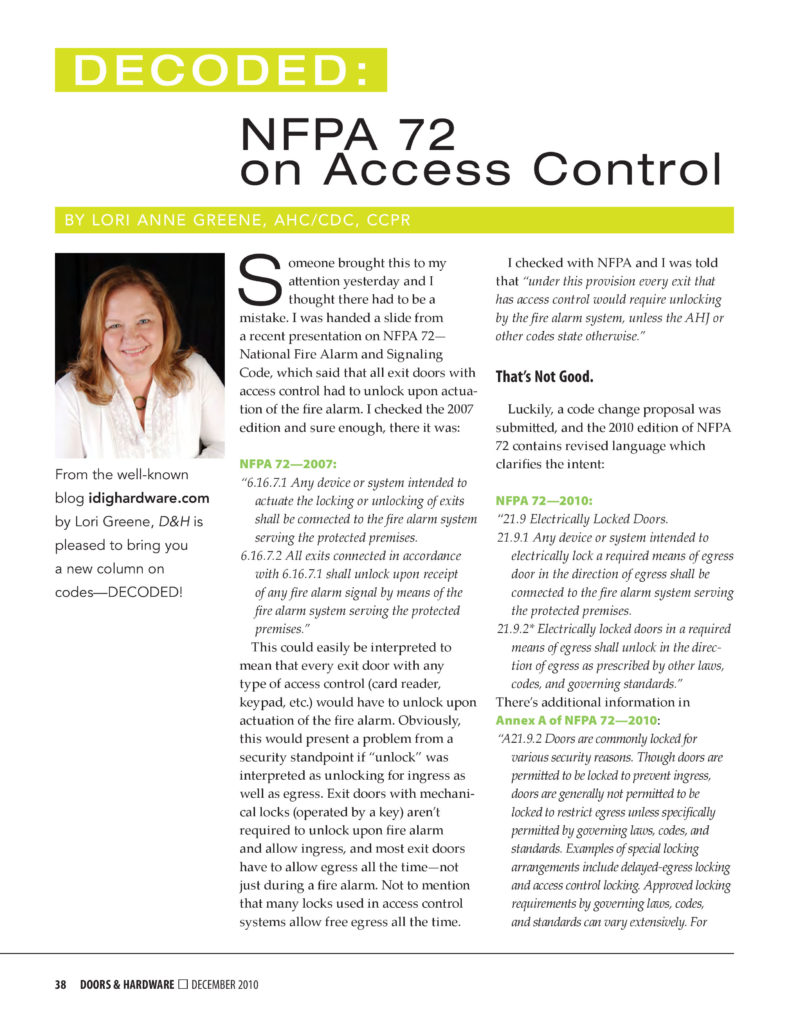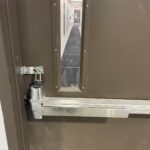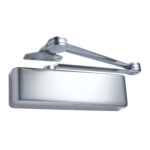We’re halfway through the anniversary celebration! Friday’s winner of the Yeti tumbler was Alison Nugent from DH Pace, and the winner of last week’s Yeti cooler was Dennis Hacker of Fanning Howey! There are still two weeks left in the contest, so click here to see how you can register to win!
This blog post will be published in the October 2019 issue of Door Security + Safety
.

 Call me crazy, but I like codes. I’m not a fan of free-flowing creative pursuits…I like rules, order. I have a degree in architecture but chose the technical field of doors and hardware because I didn’t want the quality of my work to be dependent on someone else’s opinion of my design. In 1986, I entered the door and hardware industry as a draftsman for an aluminum storefront company, then became a detailer, a project manager, and eventually a manufacturer’s representative.
Call me crazy, but I like codes. I’m not a fan of free-flowing creative pursuits…I like rules, order. I have a degree in architecture but chose the technical field of doors and hardware because I didn’t want the quality of my work to be dependent on someone else’s opinion of my design. In 1986, I entered the door and hardware industry as a draftsman for an aluminum storefront company, then became a detailer, a project manager, and eventually a manufacturer’s representative.
When I worked as a specification writer, I knew how critical it was to understand the code requirements. Without a working knowledge of the codes that had been adopted in a project’s jurisdiction, costly mistakes could be made – I could even jeopardize the life safety of building occupants. I learned at the School of Hard Knocks. I remember one school project where I did not specify panic hardware for the band room, and later had to swap out the installed locksets for rim panics. On another project I remember the architect asking me whether the pocket door hardware she had requested met the accessibility standards (it didn’t). Unfortunately, it was already installed.
Errors require time and money to correct, and generally the architect, contractor, end user, and anyone else involved in the construction process is not very happy about addressing mistakes – especially while trying to receive the Certificate of Occupancy. It was my responsibility to specify code-compliant hardware, and to inform the architect if there was a problem with what was shown on the plans, or if a requested hardware application violated the code requirements. My opinions were not always popular, but in most cases I was ready with a suggested alternative that would function as desired but keep us out of trouble with the Authority Having Jurisdiction (AHJ).
Back in the mid-90’s when I needed to learn more about the codes that applied to doors and hardware, it was not easy to acquire this knowledge. I learned about some of the codes and standards from the National Fire Protection Association (NFPA) in classes conducted by the Door & Hardware Institute – the organization now called Door Security + Safety Professionals. The challenge was that in most of the locations where I specified hardware, the building code was based on the BOCA National Building Code, not the NFPA codes. After the year 2000, the International Building Code (IBC) became the prevalent building code throughout the US.
At that time, learning about the adopted building codes and the International Fire Code (IFC) required a lot of reading and research. If you’ve ever opened a code or standard, you may have noticed that it can be difficult to find the applicable section, let alone interpret the meaning. It’s a little easier now that you can search the PDF rather than paging through a hard copy. My old code books were covered with flags, notes, and highlighting. The commentary and handbook companions to the codes and standards can also be really helpful, as they explain the intent of the codes and standards.
Another way to learn about codes is to follow the code development process and read through the reason statements that accompany each code change proposal. Most codes and standards are on a 3-year code development cycle, so every 3 years there is an opportunity to watch the next edition taking shape. The proposals are discussed at hearings with the technical committee responsible for that section, and often you can even watch these discussions online if you are interested in a particular change. I work on proposals with the Codes, Government, and Industry Affairs Committee of the Builders Hardware Manufacturers Association, and I have learned a lot from my involvement in this process.
 At least 20 years ago I decided that it would be beneficial to the industry and beyond if I shared some of the code information I had collected and made it less painful for people to learn about codes. I started with a 12-page booklet about the codes that applied to the New England states, where I was working at the time. In 2004, I expanded that booklet to the 40-page code reference guide that has been updated several times since, in order to incorporate the subsequent code changes. More than 1,000 copies of this guide are distributed in hard copy or downloaded each month. It’s a free tool that is available to anyone who needs information about the code requirements that apply to doors and hardware.
At least 20 years ago I decided that it would be beneficial to the industry and beyond if I shared some of the code information I had collected and made it less painful for people to learn about codes. I started with a 12-page booklet about the codes that applied to the New England states, where I was working at the time. In 2004, I expanded that booklet to the 40-page code reference guide that has been updated several times since, in order to incorporate the subsequent code changes. More than 1,000 copies of this guide are distributed in hard copy or downloaded each month. It’s a free tool that is available to anyone who needs information about the code requirements that apply to doors and hardware.
Because I was conducting a fair amount of training on codes and passing out dozens of code reference guides, I received a lot of questions from local architects, specifiers, hardware distributors, locksmiths, and end users. In 2009, I decided that creating a blog would give me a place to store this information, and might allow people to find answers to some of their questions without my help. Architects and specifiers would often tell me how much they hated hardware, so in a move that would never have been approved by the marketing department (if I had asked), I called the blog “iHateHardware.com.” After several months of being asked why I hated hardware, I changed the name of the site to “iDigHardware.com” (but if you’re having a particularly bad day you can use the original URL).
 In 2010, my first Decoded column appeared in Doors & Hardware magazine – now called Door Security + Safety. These articles are another helpful resource for learning about codes, as each one addresses a topic in-depth. Whether it’s panic hardware, fire or smoke doors, electrified hardware, or one of the many accessibility requirements, there is a Decoded article that covers it. I’ve often seen these articles used as handouts for code classes or forwarded to someone who was struggling with a code interpretation. The Decoded articles can be found in the archived issues of Door Security + Safety online or on the Articles page of iDigHardware.
In 2010, my first Decoded column appeared in Doors & Hardware magazine – now called Door Security + Safety. These articles are another helpful resource for learning about codes, as each one addresses a topic in-depth. Whether it’s panic hardware, fire or smoke doors, electrified hardware, or one of the many accessibility requirements, there is a Decoded article that covers it. I’ve often seen these articles used as handouts for code classes or forwarded to someone who was struggling with a code interpretation. The Decoded articles can be found in the archived issues of Door Security + Safety online or on the Articles page of iDigHardware.
For my first code classes, I would arrive with an overhead projector and a milk crate of transparencies – each framed in cardboard for durability. When PowerPoint was introduced, it revolutionized my code presentations because I used transitions, animations, sounds, and special effects liberally. This wasn’t enough to keep the attendees engaged (and awake!), so I developed several classes based on game shows, including Code Jeopardy and 1 vs. 100. To date, thousands of people have attended these classes and learned about building codes, fire codes, and accessibility standards that apply to door openings. There are also code classes on iDigHardware that can be accessed on-demand.
In today’s world, where time is of the essence and attention spans are shorter, some code-related topics are best explained with videos. Using whiteboard animations, some of the most common code questions have been covered, including various types of electrified hardware and other requirements related to egress, fire door assemblies, and accessibility. More than 30 of these videos are available on the Videos page of iDigHardware and can easily be shared when a question arises. Many AHJs have used these videos to help digest the complexities of doors and hardware, which often results in more consistent interpretations in the field.
It’s hard to believe that a website that began on a whim is now celebrating its 10-year anniversary. Who knew that people would read a blog about doors and hardware, or more specifically – the code requirements that apply to door openings? Talk about a niche! Each month, readers spend more than 1,000 hours finding answers to their code questions on iDigHardware. A community has formed around the site, where readers share their insight and experience – there are currently more than 18,000 comments on the 2,300+ published posts. If you have a question about codes or want to learn more, visit iDigHardware.com and help celebrate 10 years of codes! The next 10 years begin now!

Note: The dips are the November/December holidays each year, when people spend less time reading about hardware and more time eating turkey and cookies. 😀
You need to login or register to bookmark/favorite this content.







This is Awesome! Congratulations, Idighardware has helped me so much, I looked forward to using it when I first came aboard with Allegion.
This site was recommended to me about a year or so ago. I wasn’t expecting to like it as I am often talked into following certain sites that I end up unfollowing after a short time because I grow disinterested. I love this site and look forward to the daily posts. Thank you for your hard work and dedication to your career.
Congratulations Lori!
Congrats on the success of your page Lori! I am very thankful for its existence!
And, I am an architect who loves codes too! I’m glad to know there are others haha
WOW! Thank You Lori. You are the best. You always bring some humor with great lessons and I know that I have learned so much just by following your blog.
Not to say that I needed to hear WHY you started your blog or the website but I am EXTREMENLY happy to hear that you still have the passion and will continue these both for the next 40 years!!! Good for you Lori!!!! I literally open my email every day looking for you emails!!! Its not only the knowledge you send us but to your loyal fans who continue and augment the conversation with fantastic insight into the code and industry. As a Fire Marshal that’s encouraging to see. All I can say is Keep Up the Great Work you have built up and keep the emails coming!!! Thank You, Kevin
I think I have followed you most if not all 10 years of iDigHardware. As the Life Safety Manager at a university, my area of responsibility crosses many disciplines and countless code areas. Libraries of info land in my inbox every week. I can’t read it all. I never miss an installment of iDigHardware!
THANKS! from your biggest fan!